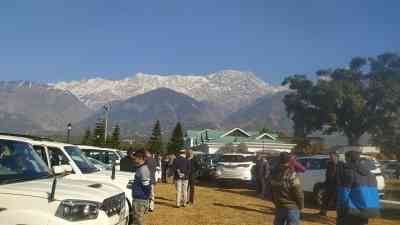'Queen of Hills' warmer than north Indian plains
Hills of Himachal Pradesh has been witnessing a 'warm winter' compared to the bone-chilling weather in most parts of the northern Indian plains and weather experts on Monday attributed this as a natural phenomenon.

VISHAL GULATI
Shimla, Jan 9 (IANS) Hills of Himachal Pradesh has been witnessing a 'warm winter' compared to the bone-chilling weather in most parts of the northern Indian plains and weather experts on Monday attributed this as a natural phenomenon.
They say the sun is shining brightly in Himachal Pradesh these days while a thick blanket of fog refuses to lift from most parts of Punjab, Haryana and the national capital.
Shimla, the Queen of Hills, is recording the "warmest" days owing to long sunny spells, while cities like Chandigarh, Amritsar, Bathinda, Ludhiana, Ambala, Karnal and New Delhi, all located in the plains, are reeling under cold wave conditions with the sun almost fogged out for over a week now.
Hill destinations have been experiencing long hours of sunny weather for over a week now and the day temperatures in most places have risen.
The dry weather would prevail in the hill state till Tuesday and thereafter there are chances of rain or snow at isolated places, the Shimla meteorological bureau said.
An official at the meteorological bureau told IANS that the minimum temperature in the hill state is up to seven degrees above the season's average.
Data accessed from the weather bureau indicates the weather in hill destinations of Shimla, Kufri, Narkanda, Chail, Kasauli, Dharamsala, Palampur, Dalhousie and Manali is "warmer" in the day, perfect for a break from the biting chill of the plains.
"What a warm sun in Shimla, a perfect break from the foggy conditions in Chandigarh," remarked tourist Naina Sharma.
"We are enjoying balmy weather," her husband Nischal Sharma added.
The official of the meteorological department said the maximum and minimum temperatures in most of the hill destinations are above average due to the clear skies.
In the plains, the humidity level of plus 80 per cent is causing fog. However, in the hills it is less that 50 per cent these days.
In Shimla, located around 7,000 feet above sea level, the minimum temperature was 10.3 degrees Celsius on Monday, whereas the maximum was 19 degrees on Sunday.
The night temperature in Dharamsala was 9.2 degrees Celsius, whereas popular tourist resort Manali saw a low of 6 degrees.
The minimum temperature of Shimla, Dharamsala and Manali was 7.5, 3.2 and seven degrees, respectively, above the season's average.
Punjab's cities Amritsar and Ludhiana and Haryana's Hisar recorded a low of 7.8 degrees, 6.8 and 3.7 degrees Celsius, respectively.
Delhi's Safdarjung observatory logged a minimum temperature of 3.8 degrees Celsius, 6.5 notches lower than in Shimla. Gurugram saw a low of 2.7 degrees.
Cold wave conditions persisted in the northwest India for the fifth day on the trot though minimum temperatures rose marginally, said the India Meteorological Department.
Manmohan Singh, director of meteorological office in Chandigarh, told IANS that Shimla, Dharamsala and Manali saw high night temperature compared to the plains.
"This is a normal phenomenon and occurs mainly due to settling of inversion layer on mountain tops," he explained.
Generally, the air becomes cooler as elevation increases.
The day temperature in most of the plains is abnormally high compared to Shimla.
The warm air lifted from the plains overlaid the existing cold air in the mountains.
He said since Shimla and Dharamsala were near the plains, the impact of inversion layer is more there.
Dense to very dense fog reported from most places in Punjab and Haryana. Cold day to severe cold day conditions observed at most places in Haryana and at isolated places in Punjab, Singh added.
In Punjab, the lowest temperature was recorded in Bathinda at 2o degrees Celsius, while it was 2.4 degrees in Haryana's Narnaul.
The weatherman said this trend of abnormally high temperatures would prevail over the hills till the western disturbances -- storm systems originating from the Caspian Sea and moving across the Afghanistan-Pakistan region -- would be active in the region.
(Vishal Gulati can be contacted at [email protected])


 IANS
IANS 








